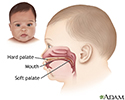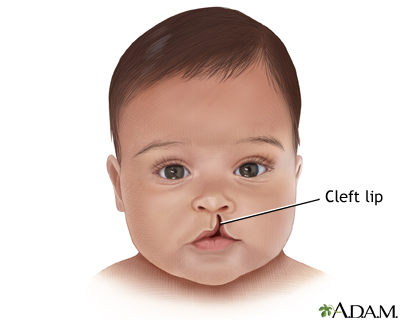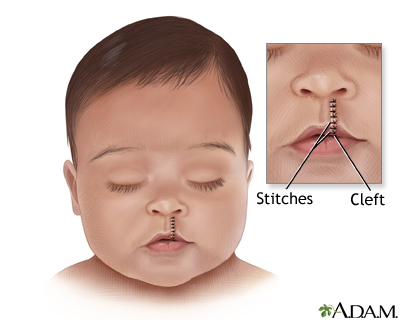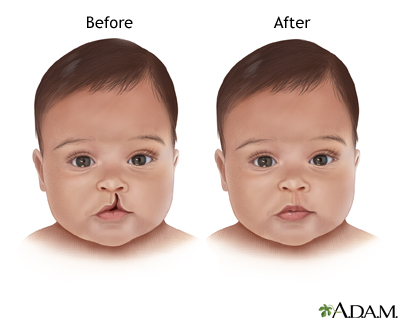Cleft lip and palate
Cleft palate; Craniofacial defect
Cleft lip and palate are birth defects that affect the upper lip and the roof of the mouth.
Causes
There are many causes of cleft lip and palate. Problems with genes passed down from 1 or both parents, drugs, viruses, or other toxins can all cause these birth defects. Cleft lip and palate may occur along with other syndromes or birth defects.
A cleft lip and palate can:
- Affect the appearance of the face
- Lead to problems with feeding and speech
- Lead to ear infections
Babies are more likely to be born with a cleft lip and palate if they have a family history of these conditions or other birth defects.
Symptoms
A child may have 1 or more birth defects.
A cleft lip may be just a small notch in the lip. It may also be a complete split in the lip that goes all the way to the base of the nose.
A cleft palate can be on 1 or both sides of the roof of the mouth. It may go the full length of the palate.
Other symptoms include:
- Change in nose shape (how much the shape changes varies)
- Poorly aligned teeth
Problems that may be present because of a cleft lip or palate are:
- Failure to gain weight
- Feeding problems
- Flow of milk through nasal passages during feeding
- Poor growth
- Repeated ear infections
- Speech difficulties
Exams and Tests
A physical examination of the mouth, nose, and palate confirms a cleft lip or cleft palate. Medical tests may be done to rule out other possible health conditions.
Treatment
Surgery to close the cleft lip is often done when the child is between 6 weeks and 9 months old. Surgery may be needed later in life if the problem has a major effect on the nose area. See also: Cleft lip and palate repair .
Cleft lip and palate repair
Cleft lip and cleft palate repair is surgery to fix birth defects of the upper lip and palate (roof of the mouth).

A cleft palate is usually closed within the first year of life so that the child's speech develops normally. Sometimes, a prosthetic device is temporarily used to close the palate so the baby can feed and grow until surgery can be done.
Continued follow-up may be needed with speech therapists and orthodontists.
Support Groups
For additional resources and information, see cleft palate support groups .
Cleft palate support groups
The following organizations are good resources for information on cleft palate:Cleft Palate Foundation -- www. cleftline. orgMarch of Dimes -- www. m...

Outlook (Prognosis)
Most babies will heal without problems. How your child will look after healing depends on the severity of their condition. Your child might need another surgery to fix the scar from the surgery wound.
Children who had a cleft palate repair may need to see a dentist or orthodontist. Their teeth may need to be corrected as they come in.
Hearing problems are common in children with cleft lip or palate. Your child should have a hearing test at an early age, and it should be repeated over time.
Your child may still have problems with speech after the surgery. This is caused by muscle problems in the palate. Speech therapy will help your child.
When to Contact a Medical Professional
Cleft lip and palate is usually diagnosed at birth. Follow your health care provider's recommendations for follow-up visits. Call your provider if problems develop between visits.
References
James JN, Costello BJ, Ruiz RL. Management of cleft lip and palate and cleft orthognathic considerations. Oral and Maxillofacial Surgery Clin . 2014;26(4): 565-572.
Tinanoff N. Cleft lip and palate. In: Kliegman, RM, Stanton BF, Behrman RE, St. Geme III JW, Schor NF, Stanton BF, eds. Nelson Textbook of Pediatrics . 19th ed. Philadelphia, PA: Elsevier Saunders; 2011:chap 302.
Wang TD, Milczuk HA. Cleft lip and palate. In: Flint PW, Haughey BH, Lund V, et al, eds. Cummings Otolaryngology: Head & Neck Surgery . 6th ed. Philadelphia, PA: Elsevier Saunders; 2015:chap 187. 2007 Feb;40(1):27-60.
-
Infant hard and soft palates - illustration
The roof of the mouth is comprised of the hard palate and the soft palate. These structures separate the nasal cavity from the mouth.
Infant hard and soft palates
illustration
-
Cleft lip repair - series
Presentation
Review Date: 4/21/2015
Reviewed By: Neil K. Kaneshiro, MD, MHA, Clinical Assistant Professor of Pediatrics, University of Washington School of Medicine, Seattle, WA. Also reviewed by David Zieve, MD, MHA, Isla Ogilvie, PhD, and the A.D.A.M. Editorial team.





